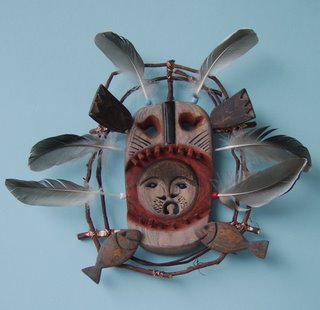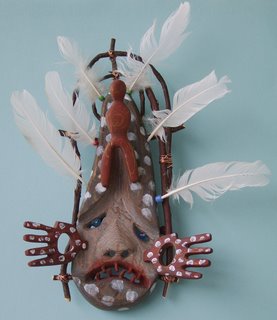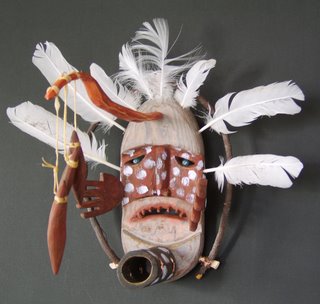The First Five
This is "Toothy Bird" - she's my favorite so far. I had a dream about her the night after I completed her. In my dream, she was talking to me, and told me to make a life-sized loon mask, whose beak could open and close, and reveal its yua, or human being (spirit) inside its mouth. The loon was a powerful figure in Yupik masks - due to its ability to travel through all three spirit worlds: water, air and land. The teeth in her wings and the human face on her back show the viewers that the bird is a powerful shaman, travelling between spirit worlds. Height: about 11 inches, width: 15 in. Cottonwood bark, glass beads, alder roots, duck feathers,copper wire, oil stain.

Seal Mask. This is paired with the mask below. Seals and other sea mammals were thought to have female spirits. The frowning stylized seal face inside the mask is feminine, as it is frowning. Female spirits and women were always portrayed frowning, and males smiling. Cottonwood bark, alder roots, duck feathers, glass beads, copper wire. Height: 9 inches, width 6 ins.

Seal Muzzle Mask. This is the mate to the seal above. She still needs a small kayak with hunter, that will be on the top center of the mask. The first kayak I carved broke. This mask is just a close-up of a seal's snout and open mouth, which reveals a stylized seal face inside. Of course the fish represent the seal's favorite food! Cottonwood bark, alder and unknown root, glass beads, copper wire, duck feathers. Height: 7 inches, width: 5 inches.

"Chalarok" or East Wind mask. He is paired with the mask below. There are a number of masks which represent the winds. Little information was gathered about the mask's meaning by the collector of the original. He is shown with a man - possibly representing a shaman riding on him. The hoops in the masks represent the universe. White feathers represent stars. White dots may represent stars, snow, or spirit eyes. The pierced hands with cut off thumbs represent the tuunraaq, who were helper spirits called upon by the shaman. Tuunraaq dwelled on the moon, and controlled game, birds and fish. It was believed the hole in the palm allowed enough animals and fish to go down to earth so man would not go hungry, but not too many animals so they would all be killed. Cottonwood bark, alder roots, glass beads, copper wire, ptarmigan feathers. Height: 9 inches, width: 5 inches.

"Negakfok" or "North Wind" mask. The tube allows the wind to blow. The dangling objects on his forehead tinkle like a wind-chime. Cottonwood bark, spruce root, alder root, glass beads, copper wire, ptarmigan feathers. Height: 8 inches, width: 4 inches.

The originals, after which these masks were modelled, were all collected in the late 1800's by American and European collectors, most of whom were missionaries. These masks all came from villages in the Yukon-Kuskokwim Delta. The originals were all large full-face masks, which were carved for specific festivals or other ritual performances. Had the collectors not bartered for the masks, they would have been destroyed - chopped up and used as firewood, or set out on the tundra to weather away. Some masks were buried with powerful shamans who created or visualized them.








